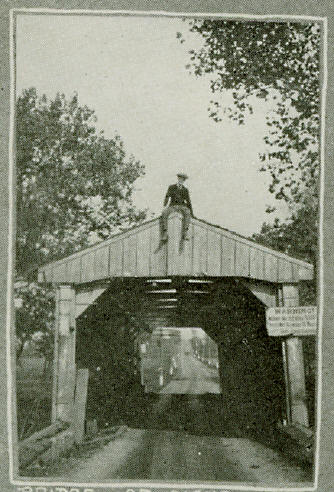|
Toms Creek Bridge stopped 'Ike,'
but not school children
 The
little covered bridge that once
carried South Seton Avenue over
Toms Creek may have stopped a
military convoy in its tracks in
1919, but it provided passage
over the creek for many area
students before it was torn down
in 1923. The
little covered bridge that once
carried South Seton Avenue over
Toms Creek may have stopped a
military convoy in its tracks in
1919, but it provided passage
over the creek for many area
students before it was torn down
in 1923.
In
1919, a military convoy was
assembled to see how quickly the
army could get from coast to
coast. Setting out from
Washington, D.C., the convoy
picked up Dwight D. Eisenhower
in Frederick, and soon got stuck
in the South Seton Covered
Bridge as it tried to wind its
way to Gettysburg. The convoy
broke up, some vehicles fording
the creek and others finding
routes around the old bridge.
Although few photographs seem to
remain of the old structure, and
little information is available
about when it was built and by
whom, there are a handful of
residents in town who have
personal memories about it.
Sister Ruth, 95, a resident of
St. Joseph's Provincial House,
lived in a house near St.
Anthony's Church until she was
19. Like the covered bridge, her
home is no longer standing.
Ruth attended
St. Euphemia's School
and Sisters' House, 5052 DePaul
Street, and, although her
parents drove her to school, she
walked home each day, on a route
that carried her through the old
bridge.
Sister said she recalled that
the road was paved then and that
it generally looked like the
current Roddy Creek Covered
Bridge located near Thurmont.
Elizabeth K. William, 92, a
life-long resident of Emmitsburg
and the area, lived on Old
Frederick Road in the vicinity
of Toll Gate Hill. She also
attended St. Euphemia's, and
walked through the bridge going
to and from school, a two and a
half mile trip each way.
William also recalls the bridge
generally looked like the
current Roddy Creek bridge, and
also remembered that there were
"a lot of road men (unemployed)
walking the road back then. I
was leery of them."
Agnes Topper, 93,
born and raised in Emmitsburg,
lived on Dry Bridge Road on a
farm while in school, and also
walked to
St. Euphemia's.
"There were no buses back then,"
she pointed out.
Topper's hike to and from school
was a three-mile journey each
way, which took her through the
old covered bridge.
"As we came to school we could
see men not working along the
side of the bridge fishing. We
were not afraid back in those
days. You didn't have the
trouble the children have now,"
Topper recalled, obviously
referring to the same men
William mentioned.
"There were names carved in the
bridge by some of the older
children," Topper remembered,
and, "They usually painted the
bridge green," a rather unusual
color for covered bridges back
then, but colors often depended
on what paint was readily
available and how much it cost.
Topper remembered that the road
(South Seton) was paved
beginning near the approach to
the bridge.
Kenneth Hardwood, project
manager with Frederick County
Office of Transportation
Engineering, Frederick County
Department of Public Works, told
The Dispatch that there were
originally more than 50 covered
bridges in Frederick County
alone during peak of covered
bridge construction in the the
mid to late-1800s.
Bridges were covered for a very
functional reason. Bridge
engineers during the 18th
century had the bridges covered
to protect the trusses (frames)
from weathering, adding decades
to the lifespan of the bridges.
They were not covered to keep
horses from shying at stream
crossings, or to keep snow out
of the bridge, or to protect
travelers.
Have your own memories of the
Covered Bridges in Emmitsburg?
If so, send them to us at: history@emmitsburg.net
|